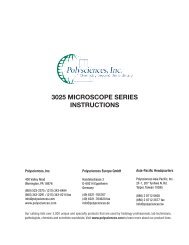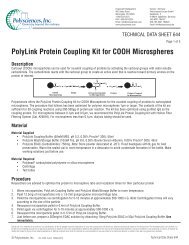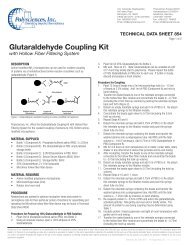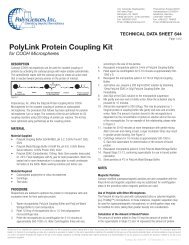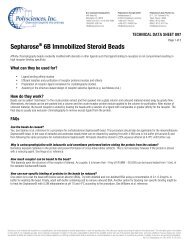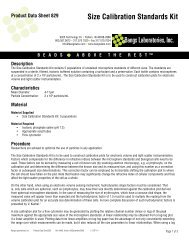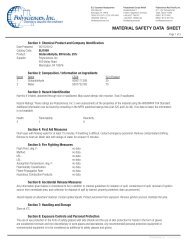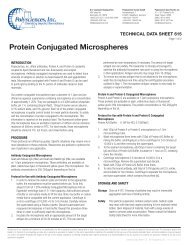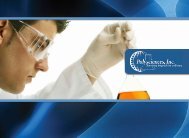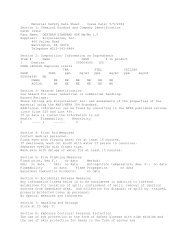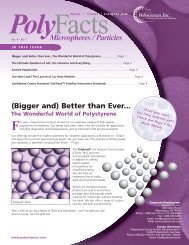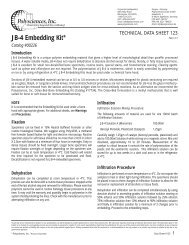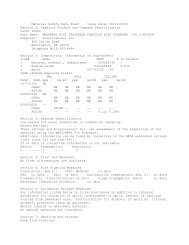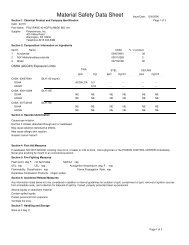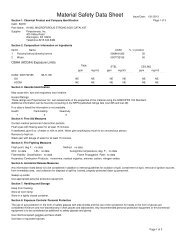Hydrophilic Monomers - Polysciences, Inc.
Hydrophilic Monomers - Polysciences, Inc.
Hydrophilic Monomers - Polysciences, Inc.
Create successful ePaper yourself
Turn your PDF publications into a flip-book with our unique Google optimized e-Paper software.
polysciences.com<br />
<strong>Hydrophilic</strong> <strong>Monomers</strong><br />
for Research Applications<br />
Introduction of hydrophilic properties into polymers is required in<br />
applications where higher water and oxygen transmission rates are<br />
desirable without sacrificing basic mechanical or physical properties<br />
of the polymer backbone. This property balancing act is particularly<br />
critical in end uses such as optical lenses, membranes, biomedical<br />
devices (e.g. topical dermal patches), breathable coatings and other<br />
high value-added applications.<br />
N, N-Dimethylacrylamide, 99.9% (CAS # 2680-03-7)<br />
Amido functional monomers increase<br />
hydrophilic properties and copolymerize<br />
well into a range of acrylate and methacrylate<br />
systems. This exceptionally high purity<br />
monomer is ideal for research in optical<br />
lens applications.<br />
Hydroxyl Functional <strong>Monomers</strong><br />
(HEMA-10) Poly Ethoxy (10) ethyl methacrylate (CAS # 25736-86-1)<br />
This homolog of HEMA bears 10 ethoxy<br />
units on the ester linkage. These<br />
water soluble pendant, non-ionic<br />
side chains not only increase water<br />
compatibility in the polymer but can<br />
enhance stabilization of latex systems<br />
alone or in combination with added non-ionic surfactants.<br />
Hydroxypolyethoxy (10) Allyl Ether (CAS # 27274-31-3)<br />
Where ester groups are undesirable<br />
due to hydrolytic conditions, allyl ethers<br />
may be useful in vinyl polymerizations<br />
through the allylic olefin to impart<br />
hydrophilic properties in aqueous solution<br />
or emulsion polymers.<br />
These higher homologs are extensions of the <strong>Polysciences</strong>, <strong>Inc</strong>. hydroxyethyl<br />
methacrylate-HEMA (Cat. # 04675) currently available as a high<br />
purity optical monomer.<br />
Physical Property Profiles of HEMA methacrylates<br />
(HEMA 10) Poly Ethoxy Hydroxypolyethoxy<br />
(10) ethyl methacrylate (10) Allyl Ether<br />
Molecular Weight 526 498<br />
Ethylene oxide, moles 10 10<br />
Active content (%) 90 99<br />
Moisture content (%) 0.5 0.2<br />
Hydroxyl number (mg KOH/mg) 98 115<br />
Inhibitor (p-benzophenone; ppm) 800 –––<br />
Appearance Viscous Liquid Low Viscosity Liquid<br />
Physical Property Profile of N, N-Dimethylacrylamide<br />
Molecular Weight 99<br />
Purity (%) 99.9<br />
Water (%) 0.1<br />
Inhibitor (MEHQ, ppm) 50<br />
Appearance<br />
Clear Liquid<br />
Ethylene Glycol Dimethacrylate, 99.7% (CAS # 97-90-5)<br />
Where crosslinking of acrylate or<br />
methacrylate polymers is required<br />
to achieve a porous network<br />
structure, ethlene glycol dimethacrylate<br />
may be used as a high<br />
purity crosslinker with bridging/ spacing capability between polymer<br />
chains.<br />
Physical Property Profile of Ethylene Glycol Dimethacrylate<br />
Molecular Weight: 198<br />
Purity (%): 99.7<br />
2-hydroxyethylmethacrylate (%): 0.3<br />
Acid Functional <strong>Monomers</strong><br />
Moisture (%): 0.03<br />
Inhibitor (MEHQ, ppm): 50<br />
Appearance: Clear Liquid<br />
Methacrylic Acid, 99.9% (CAS # 79-41-4)<br />
Beta-Carboxyethyl Acrylate, 99% (CAS # 24615-84-7)<br />
High purity carboxylated monomers increase the hydrophilicity in<br />
polymers and provide crosslinking sites for divalent ions (e.g. Zn ++ ).<br />
<strong>Polysciences</strong>, <strong>Inc</strong>. offers both methacrylic acid in high purity (99.9%)<br />
and a longer chain analog, Beta-Carboxyethyl acrylate (99%).<br />
Learn more about our line of <strong>Hydrophilic</strong> Polymers, visit www.polysciences.com
Physical Property Profiles of Acid Functional <strong>Monomers</strong><br />
Sulfonated Monomer<br />
Sodium 1-Allyloxy-2 hydroxypropyl Sulfonate (CAS # 52556-42-0)<br />
Sodium salt of the allyl ether sulfonate.<br />
It readily undergoes vinyl<br />
polymerization reactions in aqueous<br />
or emulsion systems and provides<br />
a bound source of anionically<br />
charged sulfonate groups in a polymer backbone. Anionic charge<br />
assists in latex particle stabilization in low surfactant systems but also<br />
aids in downstream formulation work to avoid the addition of high<br />
levels of excess surfactants for formulation stabilization. This improves<br />
water resistance in formulations and provides low foaming properties.<br />
Physical Property Profile of<br />
Sodium 1-Allyloxy-2-hydroxypropyl Sulfonate<br />
Molecular Weight: 218 Water (%): 60<br />
Active Polymer (% in aq. sol.): 40 pH (10% in water): 7.5<br />
Other Specialty <strong>Monomers</strong><br />
Diallyl Maleate (CAS # 99-21-3)<br />
Methacrylic Acid Beta-Carboxyethyl Acrylate<br />
CAS # 79-41-4 24615-84-7<br />
Molecular Weight 86 144<br />
Purity (%) 99.9 99<br />
Moisture (%) 0.05 0.70<br />
Inhibitor (MEHQ, ppm) 200 1,000<br />
Appearance Clear Liquid Slightly Viscous Liquid<br />
Diallyl ester of maleic acid. Once polymerized<br />
through the vinyl center adjacent to<br />
the ester groups, it provides multiple postfunctionalization<br />
target sites at the pendant<br />
allylic centers. This makes it particularly<br />
useful both in acrylic chemistry but also in<br />
combination with alkyd and polyester resins.<br />
When employed at very low levels it is an effective site for branching<br />
generation in emulsion polymers.<br />
Physical Property Profile of 2-Cyanoethyl Acrylate<br />
Molecular weight: 125 Moisture (%): 0.2<br />
Active Monomer (%): 92 Inhibitor (HQ, ppm): 700<br />
Acid Value (meq/gm): 0.03<br />
Allyl Phenyl Ether, 98% (CAS # 1746-13-0)<br />
Physical Property Profile of Allyl Phenyl Ether<br />
Molecular Weight: 134 Specific gravity (20°C): 0.97<br />
Purity (%): 98 Refractive Index (20°C): 1.52<br />
Boiling Point (C): 185<br />
Appearance: Light Yellow Liquid<br />
High purity monomer which has a high<br />
refractive index allowing it to be used as<br />
a synthon in modifying polymer refractive<br />
index properties.<br />
Appearance: Amber Liquid<br />
Description CAS # Cat. # Size<br />
(HEMA 10) Poly Ethoxy (10) ethyl methacrylate 25736-86-1 24890 100g<br />
Hydroxypolyethoxy(10) Allyl Ether 27274-31-3 24899 100g<br />
Ethylene Glycol Dimethacrylate, 99.7% 97-90-5 24896 250g<br />
N, N-Dimethylacrylamide 2680-03-7 02255 100g<br />
Methacrylic Acid, 99.9% 79-41-4 24897 250g<br />
Beta-Carboxyethyl Acrylate, 99% 24615-84-7 24891 100g<br />
Sodium 1-Allyloxy-2<br />
hydroxypropyl Sulfonate 52556-42-0 24898 100g<br />
Diallyl Maleate 99-21-3 24892 100g<br />
2-Cyanoethyl Acrylate 106-71-8 01829 100g<br />
Allyl Phenyl Ether, 98% 1746-13-0 24894 100g<br />
Physical Property Profile of Diallyl Maleate<br />
Molecular Weight: 196 Moisture (%): 0.05<br />
Active Monomer (%): 99<br />
Appearance: Clear Liquid<br />
Acidity value (meq/gm): 0.1<br />
2-Cyanoethyl Acrylate (CAS # 106-71-8)<br />
Used in a wide range of applications<br />
including photocurable resists for liquid<br />
crystal devices, photocurable polymer<br />
insulators for multilayer circuitry,<br />
electroluminescent products, graft polymers for controlled diffusion,<br />
vulcanization of rubbers and as an adhesion promoter. It is not to be<br />
confused with the alpha-cyano ethyl acrylate which is used in some<br />
Super Glue ® products.<br />
U.S. Headquarters 1(800) 523-2575 | <strong>Polysciences</strong> Europe GmbH +(49) 6221-765767 | <strong>Polysciences</strong> Asia-Pacific, <strong>Inc</strong>. (886) 2 8712 0600



